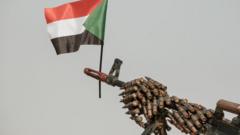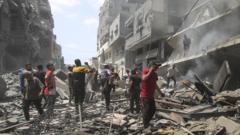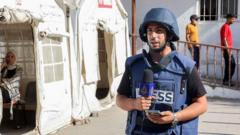Iran's carefully measured retaliation following recent attacks on its nuclear facilities indicates a strategic effort to navigate escalating hostilities with the U.S. and Israel.
Iran's Tactical Strikes: A Calculated Response Amidst U.S. and Israeli Aggression

Iran's Tactical Strikes: A Calculated Response Amidst U.S. and Israeli Aggression
As tensions flare in the Middle East, Iran attempts to regain its standing without igniting a broader conflict.
Even before launching a counter-strike, Iran sought a strategic exit from the present crisis. On Monday morning, an emergency session convened by Iran's Supreme National Security Council aimed to devise a retaliatory response to the United States, which had targeted three of Iran's significant nuclear sites over the weekend. This episode was preceded by extensive assaults from Israel, resulting in substantial damage to Iran's military hierarchy and crucial infrastructure.
Facing the need to maintain dignity on the international stage, Iran's Supreme Leader, Ayatollah Ali Khamenei, directed a response from a secure location, with multiple Iranian officials disclosing plans to retaliate. However, the ayatollah also advocated for a restrained operation—one that would minimize the risk of an all-out conflict with the U.S., as revealed by officials restricted from commenting publicly on strategic discussions.
Iran aimed to strike an American site in the region, utilizing the opportunity not only to respond but also to limit further aggressive actions from Washington. Consequently, the Islamic Revolutionary Guards Corps selected the Al Udeid Air Base in Qatar as their target. This decision stemmed from two key considerations: it is the primary American military installation in the region, believed to play a pivotal role in the orchestration of recent U.S. B-2 bombardments on Iranian nuclear targets, and its location in Qatar—a nation perceived as a relatively close ally—allowed Iranian officials to anticipate that the extent of the damage would remain within manageable limits.
Facing the need to maintain dignity on the international stage, Iran's Supreme Leader, Ayatollah Ali Khamenei, directed a response from a secure location, with multiple Iranian officials disclosing plans to retaliate. However, the ayatollah also advocated for a restrained operation—one that would minimize the risk of an all-out conflict with the U.S., as revealed by officials restricted from commenting publicly on strategic discussions.
Iran aimed to strike an American site in the region, utilizing the opportunity not only to respond but also to limit further aggressive actions from Washington. Consequently, the Islamic Revolutionary Guards Corps selected the Al Udeid Air Base in Qatar as their target. This decision stemmed from two key considerations: it is the primary American military installation in the region, believed to play a pivotal role in the orchestration of recent U.S. B-2 bombardments on Iranian nuclear targets, and its location in Qatar—a nation perceived as a relatively close ally—allowed Iranian officials to anticipate that the extent of the damage would remain within manageable limits.



















